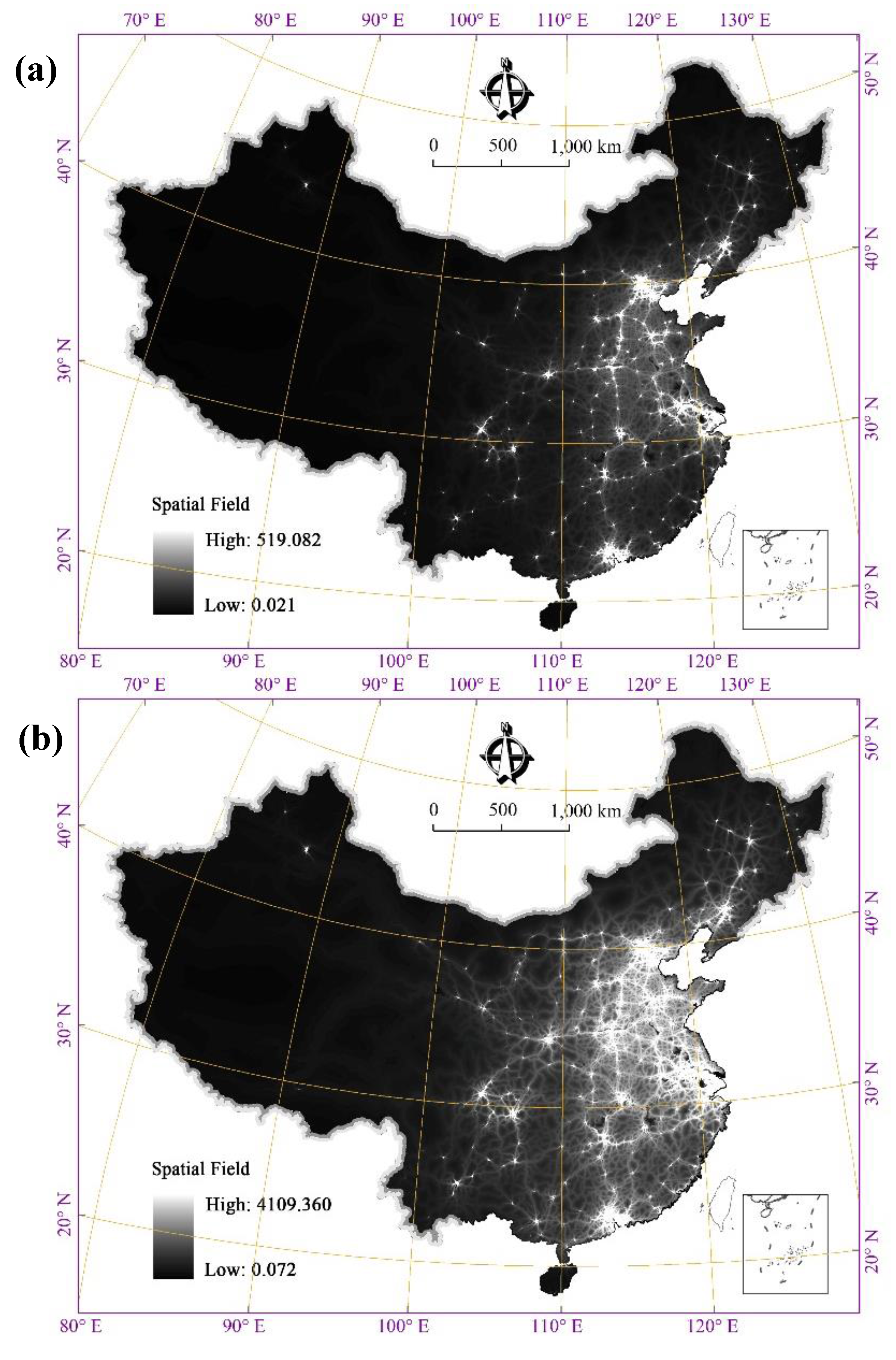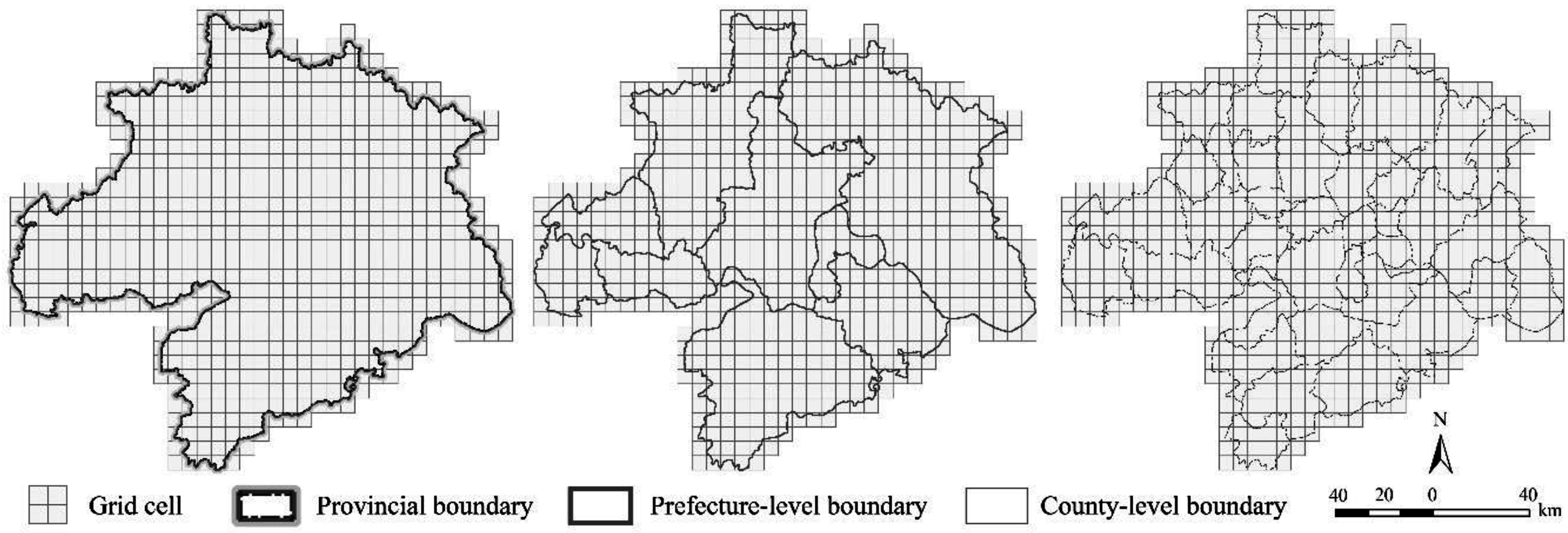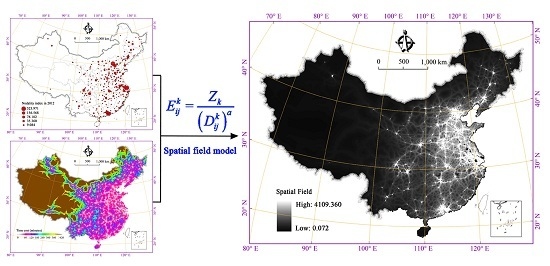Multi-Scale Analysis of Regional Inequality based on Spatial Field Model: A Case Study of China from 2000 to 2012
Abstract
:1. Introduction
2. The Spatial Field Model
2.1. Defining the Spatial Field Model
2.2. Constructing the Spatial Field Model
2.2.1. The Indicator System of the Nodality Index
| Target Layer | Criterion Layer | Specific Indicators |
|---|---|---|
| Nodality Index | Economic development condition | Gross domestic product(X1, 10, 000 RMB), per capita gross domestic product (X2, RMB), total population (X3, 10, 000 persons), gross industrial output value (X4, 10, 000 RMB), local government bugetary revenue(X5, 10, 000 RMB), total retail sales of social consumer goods (X6, 10, 000 RMB), savings deposit of urban and rural household (X7, 10, 000 RMB) |
| Social development condition | Urbanisation rate of population (X8, %), average wage of staff and workers(X9, RMB), mobile phone users (X10, 10, 000 number), number of theater and cinemas (X11, unit), total collections in public libraries (X12, 1000 copies), number of licensed/assistant doctors (X13, 10, 000 persons) | |
| Infrastructure development condition | Built-up area (X14, km2), vegetation cover in respect to built-up area (X24, %), total passenger traffic(X20, 10, 000 persons), total freight traffic (X21, 10, 000 tons), area of paved roads at year-end (X22, 10, 000 m2), number of public vehicles under operation at year-end (X23, unit) | |
| Investment environment condition | Number of fully-employed staff and workers (X15, 10, 000 persons), total investment in fixed assets (X16, 10, 000 RMB), amount of foreign capital actually utilized (X17, 10, 000 dollar), water supply (X18, 10, 000 tons), electricity consumption (X19, 10, 000 kwh) | |
| Science & technology and informatization condition | Postal and telecommunications services (X25, 10, 000 RMB), total research & development personnel (X26, persons), total educational funds (X27, 10, 000 RMB), national regular institutions of higher education (X28, unit), number of students enrollment in higher education (X29, persons) |

2.2.2. Regional Accessibility

2.3. Data Sources and Processing
3. Results Analysis

3.1. Inequality in China at Three Geographical Scales
| Year | Indicators | The Whole Country of China | ||
|---|---|---|---|---|
| Provincial-Level Unit | Prefecture-Level Unit | County-Level Unit | ||
| 2000 | Mean | 0.295 | 0.247 | 0.254 |
| Std. Dev | 0.394 | 0.219 | 0.287 | |
| Coefficient | 1.336 | 0.888 | 1.131 | |
| 2012 | Mean | 1.653 | 1.316 | 1.355 |
| Std. Dev | 2.349 | 1.314 | 2.028 | |
| Coefficient | 1.421 | 0.999 | 1.496 | |
3.2. Intra-Regional Inequality in the Three Regions Studied
| Year | Indicators | Provincial-Level Unit | Prefecture-Level Unit | County-Level Unit | ||||||
|---|---|---|---|---|---|---|---|---|---|---|
| Eastern | Central | Western | Eastern | Central | Western | Eastern | Central | Western | ||
| 2000 | Mean | 0.526 | 0.213 | 0.091 | 0.380 | 0.247 | 0.106 | 0.393 | 0.265 | 0.112 |
| Std. Dev | 0.560 | 0.098 | 0.055 | 0.296 | 0.121 | 0.079 | 0.388 | 0.220 | 0.119 | |
| Coefficient | 1.064 | 0.457 | 0.604 | 0.780 | 0.490 | 0.741 | 0.989 | 0.831 | 1.062 | |
| 2012 | Mean | 3.064 | 1.085 | 0.472 | 2.100 | 1.277 | 0.534 | 2.204 | 1.344 | 0.564 |
| Std. Dev | 3.323 | 0.565 | 0.301 | 1.833 | 0.711 | 0.390 | 3.114 | 1.165 | 0.553 | |
| Coefficient | 1.084 | 0.520 | 0.638 | 0.873 | 0.557 | 0.730 | 1.413 | 0.867 | 0.981 | |
3.3. Inequality in Relation to the Interior of North and South China
| Year | Indicators | Provincial-Level Unit | Prefecture-Level Unit | County-Level Unit | |||
|---|---|---|---|---|---|---|---|
| South | North | South | North | South | North | ||
| 2000 | Mean | 0.317 | 0.271 | 0.267 | 0.226 | 0.245 | 0.224 |
| Std. Dev | 0.492 | 0.269 | 0.258 | 0.166 | 0.298 | 0.234 | |
| Coefficient | 1.552 | 0.991 | 0.966 | 0.734 | 1.212 | 1.046 | |
| 2012 | Mean | 1.804 | 1.493 | 1.492 | 1.127 | 1.399 | 1.307 |
| Std. Dev | 2.863 | 1.730 | 1.567 | 0.935 | 2.484 | 1.346 | |
| Coefficient | 1.587 | 1.158 | 1.050 | 0.829 | 1.776 | 1.030 | |
3.4. Summary of an Evaluation of Inequality in China
| Indicators | Period | Three Economic Regions | North-South Region | |||
|---|---|---|---|---|---|---|
| Eastern | Central | Western | South | North | ||
| Development level | 2000 and 2012 | High | Medium | Low | High | Low |
| Development speed | From 2000 to 2012 | High | Medium | Low | High | Low |
| Degree of inequality | 2000 and 2012 | High | Low | Medium | High | Low |
| Increase of inequality | From 2000 to 2012 | Low | Medium | High | Low | High |
4. Discussions
4.1. Advantages of the Spatial Field Model
4.1.1. Comprehensive Evaluation of Regional Inequality
4.1.2. Provision of Aesthetically Pleasing and Highly Adaptable Presentations based on a Pixel-Based Raster
4.1.3. Realisation of Multi-Scale Analyses of Regional Inequality

4.2. Limitations and Extensions of the Spatial Field Model
4.2.1. Limitations in the Construction of the Spatial Field
4.2.2. Limitations and Extensions with Respect to the Solution Algorithm and Computational Requirements
4.2.3. Extensions Related to the Inequality Evaluation in Other Dimensions of Human Development
4.2.4. Extensions Related to the Identification of Urban Agglomerations
5. Conclusions
Acknowledgments
Author Contributions
Conflicts of Interest
References
- Sutherland, D.; Yao, S.J. Income inequality in China over 30 years of reforms. Camb. J. Reg. Econ. Soc. 2011, 4, 91–105. [Google Scholar] [CrossRef]
- Li, G.; Fang, C. Analyzing the multi-mechanism of regional inequality in China. Ann. Reg. Sci. 2014, 52, 155–182. [Google Scholar] [CrossRef]
- Yang, D.T. What has caused regional inequality in China? China Econ. Rev. 2002 2002, 13, 331–334. [Google Scholar] [CrossRef]
- Deng, X.Z.; Huang, J.K.; Rozelle, S.; Uchida, E. Economic growth and the expansion of urban land in China. Urban Stud. 2010, 47, 813–843. [Google Scholar] [CrossRef]
- Zhang, W. Rethinking Regional Disparity in China. Econ. Plan. 2001, 34, 113–138. [Google Scholar]
- Kanbur, R.; Zhang, X. Which regional inequality? The evolution of rural-urban and inland-coastal inequality in China from 1983 to 1995. J. Comp. Econ. 1999, 27, 686–701. [Google Scholar] [CrossRef]
- Fan, C.C.; Sun, M. Regional inequality in China, 1978–2006. Eurasian Geogr. Econ. 2008, 49, 1–18. [Google Scholar] [CrossRef]
- Fan, S.; Kanburb, R.; Zhang, X. China’s regional disparities: experience and policy. Rev. Dev. Financ. 2011, 1, 47–56. [Google Scholar] [CrossRef]
- Li, Y.H. Resource flows and the decomposition of regional inequality in the Beijing-Tianjin-Hebei Metropolitan Region, 1990–2004. Growth Chang. 2012, 43, 335–357. [Google Scholar] [CrossRef]
- Li, X.J.; Qiao, J.J. County level economic disparities of China in the 1990s. Acta Geogr. Sin. 2001, 56, 136–145. (in Chinese). [Google Scholar]
- Chen, J.; Fleisher, B.M. Regional income inequality and economic growth in China. J. Comp. Econ. 1996, 22, 141–164. [Google Scholar] [CrossRef]
- Liu, H. Changing regional rural inequality in China 1980–2002. Area. 2006, 38, 377–389. [Google Scholar] [CrossRef]
- Yu, D.L.; Wei, Y.H.D. Analyzing regional inequality in post-Mao China in a GIS environment. Eurasian Geogr. Econ. 2003, 44, 514–534. [Google Scholar] [CrossRef]
- Ye, X.; Wei, Y.H.D. Geospatial analysis of regional development in China: The case of Zhejiang Province and the Wenzhou model. Eurasian Geogr. Econ. 2005, 46, 445–464. [Google Scholar] [CrossRef]
- Fleisher, B.; Li, H.; Zhao, M.Q. Human capital, economic growth, and regional inequality in China. J. Dev. Econ. 2010, 92, 215–231. [Google Scholar] [CrossRef]
- Lu, D.D. Objective and framework for territorial development in China. Chin. Geogr. Sci. 2009, 19, 195–202. [Google Scholar] [CrossRef]
- Fujita, M.; Hu, D. Regional disparity in China 1985–1994: The effects of globalization and economic liberalization. Ann. Reg. Sci. 2001, 35, 3–37. [Google Scholar] [CrossRef]
- Pan, F.H.; He, C.F. Regional difference in social capital and its impact on regional economic growth in China. Chin. Geogr. Sci. 2010, 20, 442–449. [Google Scholar] [CrossRef]
- Ho, C.; Li, D. Rising regional inequality in China: Policy regimes and structural changes. Pap. Reg. Sci. 2008, 87, 245–259. [Google Scholar] [CrossRef]
- Lu, M.; Wang, E. Forging ahead and falling behind: Changing regional inequalities in post-reform China. Growth Chang. 2002, 33, 42–71. [Google Scholar] [CrossRef]
- Lyons, T.P. Intraprovincial disparities in post-Mao China: A multidimensional analysis of Fujian Province. J. Dev. Areas 1997, 32, 1–28. [Google Scholar]
- Li, Y.; Wei, Y.H.D. The spatial-temporal hierarchy of regional inequality of China. Appl. Geogr. 2010, 30, 303–316. [Google Scholar] [CrossRef]
- Bradfield, M. Regional Economics: Analysis and Policies in Canada; McGraw-Hill Ryerson Ltd.: Toronto, ON, Canada, 1988. [Google Scholar]
- Christaller, W. How I Discovered the Theory of Central Places: A Report about the Origin of Central Places; Oxford University Press: Oxford, UK, 1972. [Google Scholar]
- Perroux, F. Note on the concept of growth poles. In Regional Economics: Theory and Practice; Mckee, D.L., Dean, R.D., Leahy, W.H., Eds.; Free Press: New York, NY, USA, 1970; pp. 93–104. [Google Scholar]
- Barkley, D.L.; Henry, M.S.; Bao, S. Identifying “spread” versus “backwash” effects in regional economic areas: A density functions approach. Land Econ. 1996, 72, 336–357. [Google Scholar] [CrossRef]
- Grafton, D.J. Small-Scale growth centres in remote rural regions: The case of Alpine Switzerland. Appl. Geogr. 1984, 4, 29–46. [Google Scholar] [CrossRef]
- Richardson, H.W. Growth pole spillovers: The dynamics of backwash and spread. Reg. Stud. 2007, 41, S27–S35. [Google Scholar] [CrossRef]
- Krugman, P. Increasing returns and economic geography. J. Polit. Econ. 1991, 99, 483–499. [Google Scholar] [CrossRef]
- Castell, M. The Rise of Network Society; Social Science Academic Press: Beijing, China, 2000. [Google Scholar]
- Scott, A.J. Global City-Regions: Trends, Theory, Policy; Oxford University Press: Oxford, UK, 2002. [Google Scholar]
- Short, J.R. Global Metropolitan: Globalizing Cities in a Capitalist World; Routledge: London, UK, 2004. [Google Scholar]
- Guan, X.L.; Fang, C.L.; Luo, K. Regional economic development disparity of China: An application of spatial field. Scientia Geographica Sinica. 2012, 32, 1055–1065. [Google Scholar]
- Haynes, K.E.; Fotheringham, A.S. Gravity and Spatial Interaction Models; Sage Publications: Beverly Hills, CA, USA, 1984. [Google Scholar]
- Wang, F.H.; Guldmann, J.M. Simulating urban population density with a gravity-based model. Socio-Econ. Plan. Sci. 1996, 30, 245–256. [Google Scholar] [CrossRef]
- Batten, D.F.; Boyce, D.E. Spatial interaction, transportation, and interregional commodity flow models. Handb. Reg.Urban Econ. 1987, 1, 357–406. [Google Scholar]
- Chen, Y.G. The distance-decay function of geographical gravity model: Power law or exponential law? Chaos Solitons Fractals. 2015, 77, 174–189. [Google Scholar] [CrossRef]
- Carrothers, G.A.P. An historical bedew of the gravity and potential concepts of human interaction. J. Am. Inst. Plan. 1956, 22, 94–102. [Google Scholar] [CrossRef]
- Preston, R E. Two centrality models. Yearb. Assoc. Pac. Coast Geogr. 1970, 32, 59–78. [Google Scholar]
- Song, S.F.; Kevin, H.L. Urbanization and city size distribution in China. Urban Stud. 2002, 39, 2317–2327. [Google Scholar] [CrossRef]
- Fang, C.L.; Guan, X.L.; Lu, S.S.; Zhou, M.; Deng, Y. Input-Output efficiency of urban agglomerations in China: An application of Data Envelopment Analysis (DEA). Urban Stud. 2013, 50, 2766–2790. [Google Scholar] [CrossRef]
- Goodall, B. Dictionary of Human Geography; Penguin: London, UK, 1987. [Google Scholar]
- Wan, N.; Zhan, F.B.; Zou, B. A relative spatial access assessment approach for analyzing potential spatial access to colorectal cancer services in Texas. Appl. Geogr. 2012, 32, 291–299. [Google Scholar] [CrossRef]
- Wang, Z.B.; Xu, J.G.; Fang, C.L.; Xu, L.; Qi, Y. The study on county accessibility in China: Characteristics and effects on population agglomeration. J. Geogr. Sci. 2011, 21, 18–34. [Google Scholar] [CrossRef]
- Wang, L.; Deng, Y.; Liu, S.H.; Wang, J.H. Research on urban spheres of influence based on improved field model in central China. J. Geogr. Sci. 2011, 21, 489–502. [Google Scholar] [CrossRef]
- Chan, K W. The Chinese hukou system at 50. In Eurasian Geogr. Econ.; 2009; Volume 50, pp. 197–221. [Google Scholar]
- Zhou, Y.X.; Ma, L.J.C. China’s urban population statistics: A critical evaluation. Eurasian Geogr. Econ. 2005, 46, 272–289. [Google Scholar] [CrossRef]
- Wang, Y.; Fang, C.L.; Xiu, C.L.; Liu, D.Q. A new approach to measurement of regional inequality in particular directions. Chin. Geogr. Sci. 2012, 22, 705–717. [Google Scholar] [CrossRef]
- Deichmann, U.; Balk, D.; Yetman, G. Transforming Population Data for Interdisciplinary Usages: From Census to Grid. 2001. Available online: http://sedac.ciesin.org/gpw-v2/GPWdocumentation.pdf (accessed on 12 July 2015).
- Mennis, J. Generating surface models of population using dasymetric mapping. Prof. Geogr. 2003, 55, 31–42. [Google Scholar]
- Langford, M.; Unwin, D.J. Generating and mapping population density surfaces within a geographical information system. Cartogr. J. 1994, 31, 21–26. [Google Scholar] [CrossRef] [PubMed]
- Wei, Y.H.D. Regional inequality in China. Prog. Hum. Geogr. 1999, 23, 49–59. [Google Scholar] [CrossRef]
- Poon, J.P.H.; Shang, Q.Y. Regional wage inequality in China, 1996–2010. Eurasian Geogr. Econ. 2012, 53, 338–355. [Google Scholar] [CrossRef]
© 2015 by the authors; licensee MDPI, Basel, Switzerland. This article is an open access article distributed under the terms and conditions of the Creative Commons Attribution license (http://creativecommons.org/licenses/by/4.0/).
Share and Cite
Lu, S.; Guan, X.; Yu, D.; Deng, Y.; Zhou, L. Multi-Scale Analysis of Regional Inequality based on Spatial Field Model: A Case Study of China from 2000 to 2012. ISPRS Int. J. Geo-Inf. 2015, 4, 1982-2003. https://doi.org/10.3390/ijgi4041982
Lu S, Guan X, Yu D, Deng Y, Zhou L. Multi-Scale Analysis of Regional Inequality based on Spatial Field Model: A Case Study of China from 2000 to 2012. ISPRS International Journal of Geo-Information. 2015; 4(4):1982-2003. https://doi.org/10.3390/ijgi4041982
Chicago/Turabian StyleLu, Shasha, Xingliang Guan, Danlin Yu, Yu Deng, and Linjie Zhou. 2015. "Multi-Scale Analysis of Regional Inequality based on Spatial Field Model: A Case Study of China from 2000 to 2012" ISPRS International Journal of Geo-Information 4, no. 4: 1982-2003. https://doi.org/10.3390/ijgi4041982






